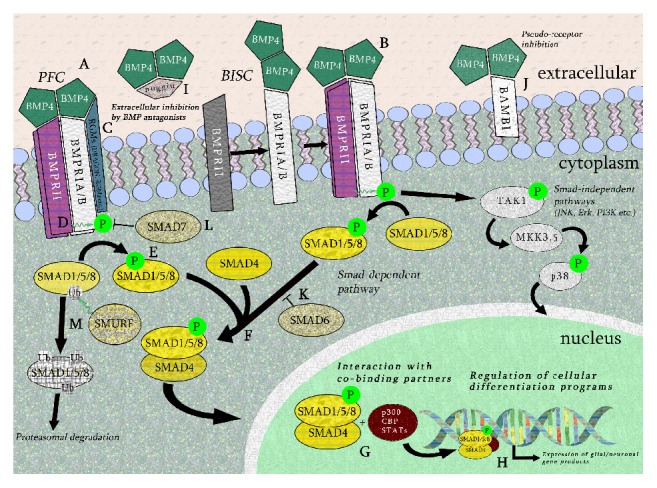Figure 1.

General BMP4 cellular signalling pathway. BMP4 dimers may bind to preformed complexes (PFCs, A), in which BMPRI Type I and Type II receptors are already bound at the cell surface, or by firstly binding to the Type I receptor and inducing the Type II receptor to the complex (BMP-induced signalling complex or BISC, B). Repulsive guidance molecules (RGMa, DRAGON, etc.) may enhance binding of the BMP4 dimer to the Type I receptors in both PFC and BISC binding (C). In the canonical SMAD-dependent pathway, the constitutively active Type II receptor kinase domain phosphorylates a glycine-serine-rich area known as the “GS box” on the Type I receptor (D). The activated Type I receptor sequentially phosphorylates receptor-associated SMADs (SMAD1, SMAD5, and SMAD8 in the case of BMP4) (E). These receptor-associated SMADs then form complexes with Co-SMAD4 (F), enter the nucleus, and further associate with cobinding partners including p300, CBP, STATs, and others (G). These heteromeric complexes then act as transcription factors to regulate the expression of neuronal and glial gene products (H). Extracellular inhibitors of the BMP4, such as noggin, bind BMP4 prior to receptor binding (I). Pseudoreceptors such as BAMBI bind BMP4 dimers but do not propagate downstream signalling activity to a lack of an intracellular kinase domain (J). Other inhibitory intracellular factors include SMAD6, SMAD7, and SMURF. SMAD6 competes with SMAD4 for binding to receptor-associated SMADs (K), SMAD7 blocks the kinase domain of BMP Type I receptors (L), and SMURF mediates ubiquitination and subsequent proteasomal degradation of receptor SMAD1, SMAD5, and SMAD8 (M). Other SMAD-independent pathways may be activated by BMP4, such as MAPK/p38, JNK, Erk, and PI3K (MAPK/p38 pathway shown in this figure).
